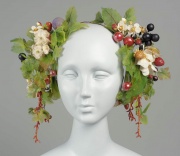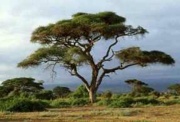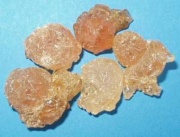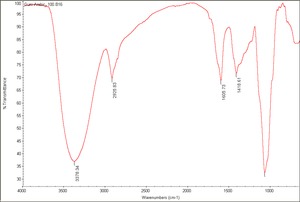Difference between revisions of "Gum arabic"
| Line 1: | Line 1: | ||
| − | [[File:51.360-SC120628.jpg|thumb|]] | + | [[File:51.360-SC120628.jpg|thumb|Womans' headress<br>MFA# 51.360]] |
== Description == | == Description == | ||
| − | + | [[File:Acacia-treef5.jpg|thumb|Acacia tree]] | |
A water soluble gum commonly used in binding media of paints. Gum arabic is the amorphous exudate from the stem of several species of [[Acacia]] trees, especially ''Acacia senegal ''and ''Acacia arabica'', found in tropical and subtropical areas of the world. Most gum arabic coming from the sub-Sahara region in Africa. Gum arabic contains [[arabinose]], [[galactose]], [[rhamnose]], and glucuronic acid. It is sold in the form of round lumps, granules, thin flakes or as a powder; all of which may be white or slightly yellowish. Gum arabic is completely soluble in hot and cold water, yielding a viscous solution. However, heating a gum arabic solution to the boiling point will cause it to darken and will change its adhesion properties. Aqueous solutions of gum arabic will precipitate or gel with the addition of ferric salts, [[borax]], [[ethyl alcohol|alcohol]], or [[sodium silicate]]. Gum arabic is used in watercolor paints, inks, lithographs, and for textile sizing. The earliest known inks consisted of gum arabic and [[lampblack]]. | A water soluble gum commonly used in binding media of paints. Gum arabic is the amorphous exudate from the stem of several species of [[Acacia]] trees, especially ''Acacia senegal ''and ''Acacia arabica'', found in tropical and subtropical areas of the world. Most gum arabic coming from the sub-Sahara region in Africa. Gum arabic contains [[arabinose]], [[galactose]], [[rhamnose]], and glucuronic acid. It is sold in the form of round lumps, granules, thin flakes or as a powder; all of which may be white or slightly yellowish. Gum arabic is completely soluble in hot and cold water, yielding a viscous solution. However, heating a gum arabic solution to the boiling point will cause it to darken and will change its adhesion properties. Aqueous solutions of gum arabic will precipitate or gel with the addition of ferric salts, [[borax]], [[ethyl alcohol|alcohol]], or [[sodium silicate]]. Gum arabic is used in watercolor paints, inks, lithographs, and for textile sizing. The earliest known inks consisted of gum arabic and [[lampblack]]. | ||
| − | [[File: | + | [[File:Arabic-gumf5.jpg|thumb|Pieces of gum arabic]] |
| − | |||
== Synonyms and Related Terms == | == Synonyms and Related Terms == | ||
| Line 12: | Line 11: | ||
[[[SliderGallery rightalign|Gum Arabic, 100.B16.TIF~FTIR (MFA)]]] | [[[SliderGallery rightalign|Gum Arabic, 100.B16.TIF~FTIR (MFA)]]] | ||
| − | == | + | == Risks == |
| − | Soluble in hot and cold water, glycerol and propylene glycol. Insoluble in ethanol and hydrocarbon solvents. Very little autofluorescence. Produces no color in iodine. | + | * Skin contact and inhalation may cause allergic reactions. |
| + | * Nonflammable. | ||
| + | |||
| + | == Physical and Chemical Properties == | ||
| + | |||
| + | * Soluble in hot and cold water, glycerol and propylene glycol. Insoluble in ethanol and hydrocarbon solvents. | ||
| + | * Very little autofluorescence. | ||
| + | * Produces no color in iodine. | ||
{| class="wikitable" | {| class="wikitable" | ||
| Line 22: | Line 28: | ||
|- | |- | ||
! scope="row"| Density | ! scope="row"| Density | ||
| − | | 1.35-1.49 | + | | 1.35-1.49 g/ml |
|- | |- | ||
! scope="row"| Refractive Index | ! scope="row"| Refractive Index | ||
| Line 28: | Line 34: | ||
|} | |} | ||
| − | == | + | ==Resources and Citations== |
| − | + | * R.Newman, M.Serpico, "Adhesives and Binders" in ''Ancient Egyptian Materials and Technology'', P.Nicholson, I.Shaw (eds.), Cambridge University Press, 2000, p. 475-494. | |
| − | |||
| − | |||
| − | |||
| − | |||
| − | |||
| − | |||
| − | |||
| − | |||
| − | |||
| − | |||
| − | |||
| − | |||
| − | |||
| − | |||
| − | |||
| − | |||
* ''Ancient Egyptian Materials and Technologies'', Paul Nicholson, Ian Shaw (eds.), Cambridge University Press, Cambridge, 2000 Comment: R.Newman, M.Serpico, "Adhesives and Binders" | * ''Ancient Egyptian Materials and Technologies'', Paul Nicholson, Ian Shaw (eds.), Cambridge University Press, Cambridge, 2000 Comment: R.Newman, M.Serpico, "Adhesives and Binders" | ||
| Line 51: | Line 41: | ||
* Richard S. Lewis, ''Hawley's Condensed Chemical Dictionary'', Van Nostrand Reinhold, New York, 10th ed., 1993 | * Richard S. Lewis, ''Hawley's Condensed Chemical Dictionary'', Van Nostrand Reinhold, New York, 10th ed., 1993 | ||
| − | * ''Encyclopedia Britannica'', http://www.britannica.com Comment: Acacia. Retrieved June 1, 2003 | + | * ''Encyclopedia Britannica'', http://www.britannica.com Comment: Acacia. Retrieved June 1, 2003. |
| − | * Wikipedia | + | * Wikipedia: http://en.wikipedia.org/wiki/Gum_arabic (Accessed Nov. 2, 2005) |
* R. J. Gettens, G.L. Stout, ''Painting Materials, A Short Encyclopaedia'', Dover Publications, New York, 1966 | * R. J. Gettens, G.L. Stout, ''Painting Materials, A Short Encyclopaedia'', Dover Publications, New York, 1966 | ||
Latest revision as of 13:08, 27 August 2022
Description
A water soluble gum commonly used in binding media of paints. Gum arabic is the amorphous exudate from the stem of several species of Acacia trees, especially Acacia senegal and Acacia arabica, found in tropical and subtropical areas of the world. Most gum arabic coming from the sub-Sahara region in Africa. Gum arabic contains Arabinose, Galactose, Rhamnose, and glucuronic acid. It is sold in the form of round lumps, granules, thin flakes or as a powder; all of which may be white or slightly yellowish. Gum arabic is completely soluble in hot and cold water, yielding a viscous solution. However, heating a gum arabic solution to the boiling point will cause it to darken and will change its adhesion properties. Aqueous solutions of gum arabic will precipitate or gel with the addition of ferric salts, Borax, alcohol, or Sodium silicate. Gum arabic is used in watercolor paints, inks, lithographs, and for textile sizing. The earliest known inks consisted of gum arabic and Lampblack.
Synonyms and Related Terms
goma arábiga (Esp.); gomme d'acacia (Fr.); gomme arabique (Fr.); gomma di acacia (It); gomma arabica (It); kordofan; picked turkey; white sennar; senegal gum; ghezineh gum; gomme blonde; gomme blanche; gum acacia, East India gum; kami; wattle gum
Risks
- Skin contact and inhalation may cause allergic reactions.
- Nonflammable.
Physical and Chemical Properties
- Soluble in hot and cold water, glycerol and propylene glycol. Insoluble in ethanol and hydrocarbon solvents.
- Very little autofluorescence.
- Produces no color in iodine.
| CAS | 9000-01-5 |
|---|---|
| Density | 1.35-1.49 g/ml |
| Refractive Index | 1.476 (solid) |
Resources and Citations
- R.Newman, M.Serpico, "Adhesives and Binders" in Ancient Egyptian Materials and Technology, P.Nicholson, I.Shaw (eds.), Cambridge University Press, 2000, p. 475-494.
- Ancient Egyptian Materials and Technologies, Paul Nicholson, Ian Shaw (eds.), Cambridge University Press, Cambridge, 2000 Comment: R.Newman, M.Serpico, "Adhesives and Binders"
- Richard S. Lewis, Hawley's Condensed Chemical Dictionary, Van Nostrand Reinhold, New York, 10th ed., 1993
- Encyclopedia Britannica, http://www.britannica.com Comment: Acacia. Retrieved June 1, 2003.
- Wikipedia: http://en.wikipedia.org/wiki/Gum_arabic (Accessed Nov. 2, 2005)
- R. J. Gettens, G.L. Stout, Painting Materials, A Short Encyclopaedia, Dover Publications, New York, 1966
- Ralph Mayer, A Dictionary of Art Terms and Techniques, Harper and Row Publishers, New York, 1969 (also 1945 printing)
- Matt Roberts, Don Etherington, Bookbinding and the Conservation of Books: a Dictionary of Descriptive Terminology, U.S. Government Printing Office, Washington DC, 1982
- M. Doerner, The Materials of the Artist, Harcourt, Brace & Co., 1934
- Reed Kay, The Painter's Guide To Studio Methods and Materials, Prentice-Hall, Inc., Englewood Cliffs, NJ, 1983
- Michael McCann, Artist Beware, Watson-Guptill Publications, New York City, 1979
- Book and Paper Group, Paper Conservation Catalog, AIC, 1984, 1989
- John S. Mills, Raymond White, The Organic Chemistry of Museum Objects, Butterworth Heineman, London, 2nd ed., 1994
- Thomas B. Brill, Light Its Interaction with Art and Antiquities, Plenum Press, New York City, 1980 Comment: ref. index = solid=1.476; 10% solution = 1.334
- I.W. Cottrell, J.K. Baird, gums chapter
- Random House, Webster's Encyclopedic Unabridged Dictionary of the English Language, Grammercy Book, New York, 1997
- The Merck Index, Martha Windholz (ed.), Merck Research Labs, Rahway NJ, 10th edition, 1983
- Art and Architecture Thesaurus Online, http://www.getty.edu/research/tools/vocabulary/aat/, J. Paul Getty Trust, Los Angeles, 2000
- Website address 1 Comment: "Violin Varnish Glossary" at www.violins.on.ca/luthier.vargloss.html
- CRC Handbook of Chemistry and Physics, Robert Weast (ed.), CRC Press, Boca Raton, Florida, v. 61, 1980 Comment: density=1.3-1.4; ref. index=1.480



